Copyright © Tetbury in Bloom
This website uses cookies - but only to count visitors anonymously. Feel free to disable cookies if you don’t want to be counted.

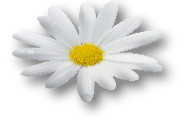

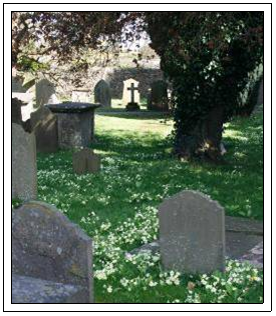
St Marys’ Churchyard in Spring
The Churchyard Project
In 2009, with generous sponsorship from IHS and funding from the Tetbury Parochial Church Council, we started a long term project to improve the look of St Marys’ churchyard, including the introduction of wildflowers where we could to maintain a “country churchyard” feel whilst doing justice to the magnificent church with its beautiful slender spire that dominates the views for miles around.
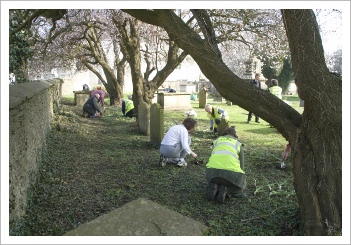
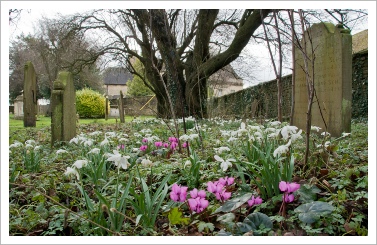
Planting the snowdrops and cyclamen under the trees and the results of our efforts several years on
Since we adopted the churchyard much work has been carried out to create a balance between the ‘formal’ and ‘natural’ planting schemes.
‘Natural’ Planting
Many hundreds of English bluebell bulbs, snowdrops, autumn and spring flowering cyclamen have been planted under the trees to form carpets of flowers in the early spring.
Small pockets of perennial wildflowers were planted amongst the gravestones in strategic places. The wildflowers were chosen for their flowering times and their attractiveness to butterflies and bees. They include Red Campion, Common Toad Flax, Musk Mallow, Field Scabious, Meadow Cranesbill, Bird’s Foot Trefoil, Ox Eye Daisy, Self Heal & Knapweed. These join the many other wildflowers that we’ve identified in the churchyard; Common Primroses, which grow in their hundreds, Celandine, Viola, Forget Me Not, Ivy leafed Toadflax, Cow Parsley, White Dead Nettle and wild strawberries to name but a few.
The churchyard is not only home to over 31 species of wildflowers, a survey in December 2008 of the limestone tombs and headstones by local bryologist, Peter Martin, identified 41 species of mosses - a similar group of plants as those found in boulder-strewn areas near limestone cliffs. Among them was the first recording in Gloucestershire for over fifty years of Tortula muralis aesitiva.
************
Formal Beds
Along the pathways, a more formal approach was taken. The grass has always been kept neat and tidy by the town council ground staff, however the old, haphazardly located rose beds, were in much need of attention. After careful consideration, the decision was taken to dig the roses out and find a new home for them in Anniversary Gardens.
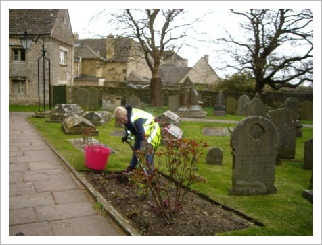
Emptying the old rose beds to create the new semi circular beds
The beds were relocated to better positions, shaped into semi circles and the soil improved with a good addition of well rotted manure. Sustainable evergreen plants were planted to give all year round interest and the colour scheme was chosen to complement the dark leafed trees using dark leafed heuchera and 2 types of penstemon – red flowering ‘Garnet’ and pink flowering ‘Hidcote Pink’. In the summer, antirrhinums and geraniums are planted to carry extra colour throughout the season and in Autumn 2009 over 1000 tulip bulbs in colours of reds, oranges, purples and pinks were planted in the formal beds which now give a fantastic display during April and May,
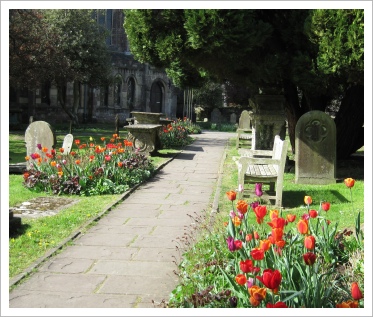
Tulip display in Spring
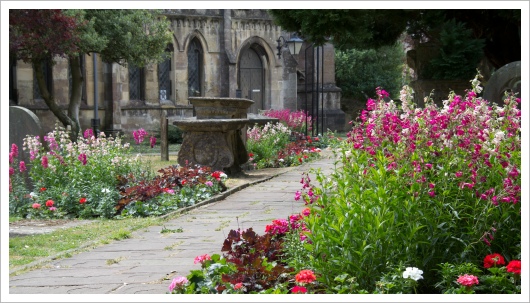
Summer display using penstemons, heuchera, antirrhinums and bedding geraniums.
To make entering the churchyard more inviting, we created two new formal beds either side of the main gates and another bed surrounding the lamp at the end of the path to draw you in. The large clumps of daffodils that were originally positioned either side of the main gates, were dug out, split and replanted throughout the churchyard.
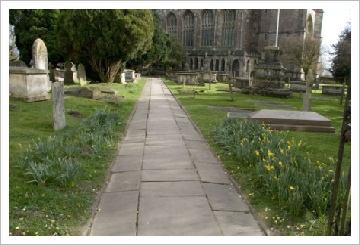
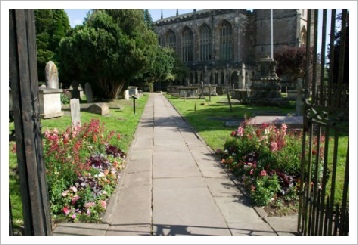
The daffodils either side of the main gate were relocated elsewhere in the churchyard and 2 new formal beds were created
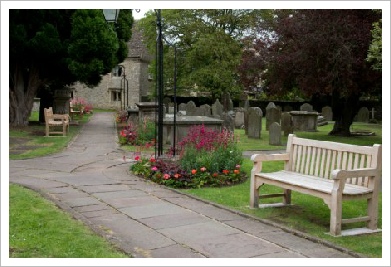
Bed surrounding the lamp at the end of the main path to draw you in.
This picture also shows you 3 of the 7 benches we have supplied and installed in the churchyard
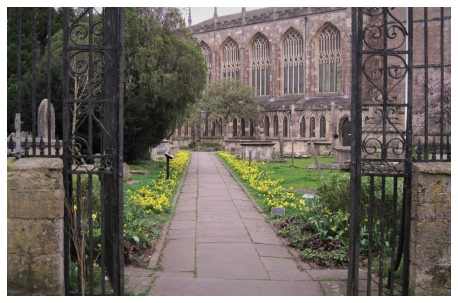
In autumn 2020 we planted over 1000 Tete a Tete bulbs along the path from the main gates and the results in spring 2021 were well worth the effort!
************
Memorial Bed by the Bell Tower Door
By the Bell Tower Door which is on the north west side of the church building, there is a memorial bed for two sisters of the parish, Mary Barnard and Edith Horner. In 2009 the bed was crying out for a complete makeover. All the old overgrown shrubs were therefore removed, the bed was reshaped and the soil improved with plenty of manure. The location of this bed must win the prize of being in the windiest corner in the United Kingdom, so much thought had to be given to decide what to plant there. The location also doesn’t receive any direct sunlight apart from perhaps the very last ½ hour before the sun goes down. We decided to try planting the evergreen euonymus in the gold and silver varieties together with dark leafed heuchera. In the summer months we added bedding begonias and small fuchsias and against all the odds – they all survived and in fact thrived!
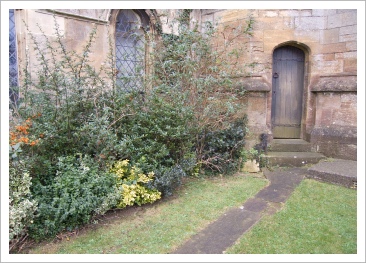
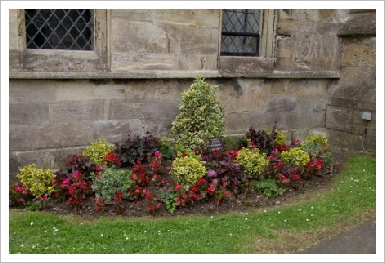
Before the makeover and after
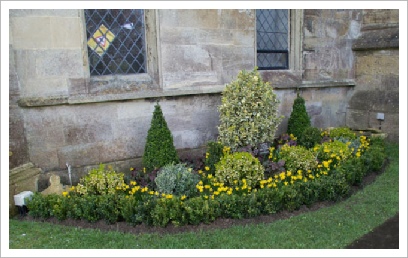
In 2014 a low box hedge was added to the front of the bed which acts as a wind break and
the addition of 4 box cones gives the planting scheme more shape and interest
************
The Substation bed
At the west side of the churchyard, to semi camouflage an electric substation, we created a mixed shrub and perennial bed using a ‘loose and informal’ planting style. Hydrangeas, ferns, pulmonaria, cranesbill, spiraea and iris, amongst others, look wonderful in this otherwise unattractive corner.
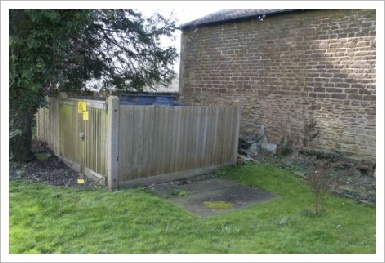
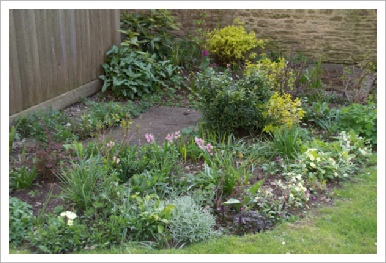
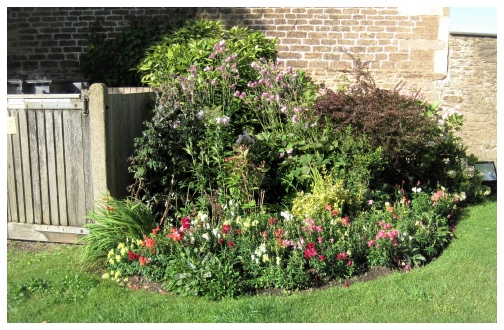
The Substation Bed during the summer months in recent years
************
Memorial Bed at the Rear of The Church
In 2011 a new bed was created at the rear of the church to surround the memorial stones of Canon Michael Sherwood who was the vicar at St Mary’s Church between 1961 and 1986 and Derek Bowsher who had been a church warden. The bed was planted with different coloured heuchera, fuchsias & ferns which has proved extremely successful and is very attractive.
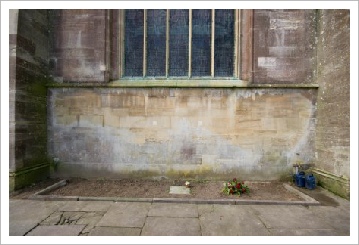
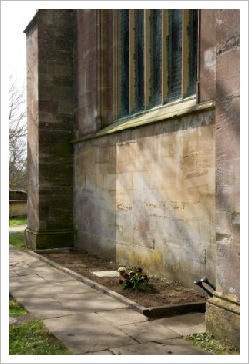

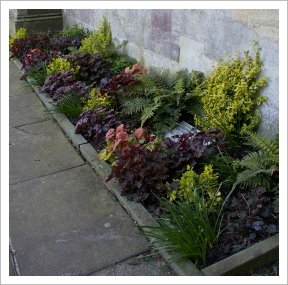
Spring and Summer Display
************
The Fern Bed
To improve the look of a dark dank corner at the rear of the church, we have planted it with shade tolerant plants such as evergreen ferns, pulmonaria, heuchera, lily of the valley, cyclamen, snowdrops, crocus to name but a few.
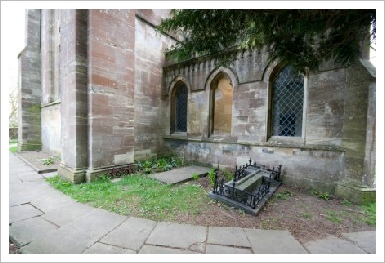
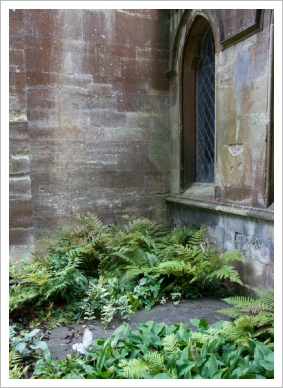
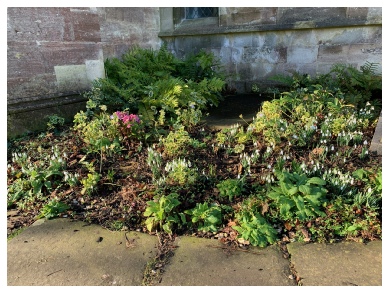
The fern bed in March 2025
***********
Remembrance Garden
In 2014, a Remembrance Garden was created at the south west corner of the church building, where relatives can inter the ashes of their love ones. Using small colourful foliage shrubs together with long flowering perennials we designed the beds that run alongside the church walls. We also created a small bed, bordered by a low hedge of box bushes, on 3 sides of the memorial cross.
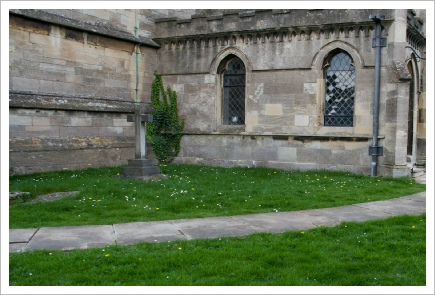
The south west corner of the church before the creation of the Remembrance Garden
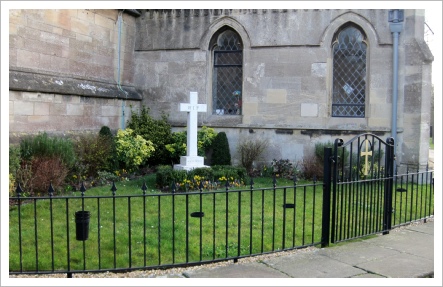
The Remembrance Garden early Spring
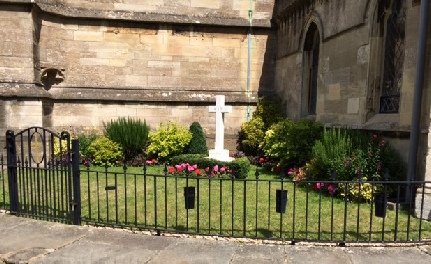
The Remembrance Garden during the summer months
************
Wedding Cake Tree
Tetbury is the home town to Highgrove, the country residence of Their Majesties King Charles III and Queen Camilla. Prince William spent much time here whilst growing up and to commemorate the Royal wedding of Prince William and Kate Middleton in 2011, in partnership with the Tetbury Evening Women’s Institute (the organisation used to have two branches, named after the time of day when they met), HRH The Duchess of Cornwall as she was then, was invited to come and plant a Wedding Cake Tree (Cornus Controversa Variegata) in the large open area behind the Church. With its small creamy-white flowers covering the green and cream leafed horizontal branches in May, followed by small black berries in autumn, it will be an attractive sight as it matures.
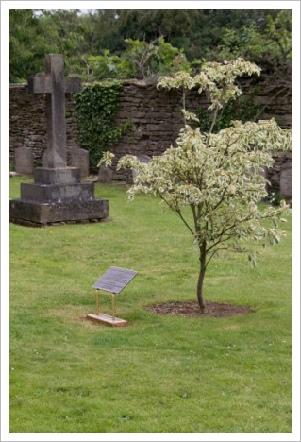

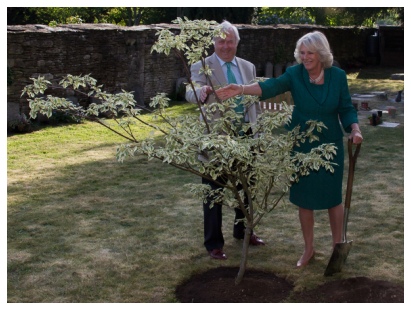
HRH The Duchess of Cornwall in May 2011, planting the Wedding Cake tree with a little help from the then Mayor of Tetbury, Stephen Hirst
************
The South Side of the Churchyard
In 2017, having already purchased and installed 4 other benches for the churchyard, on which people can sit quietly and take in the wonderful tranquil atmosphere of the surroundings, we instigated the purchase and installation of 3 more to go on the south side of the church. With assistance from the town council ground staff and some church members, we started the project….
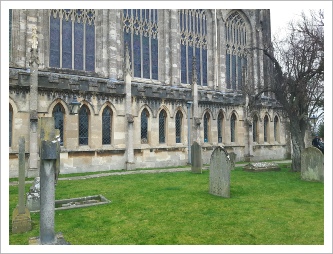
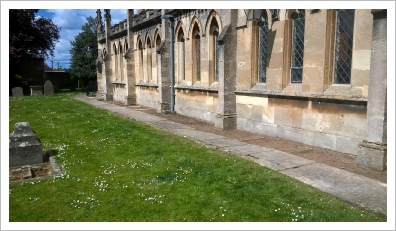
Before the installation of the benches and having removed the grass in preparation
The alcoves of the building made natural spaces for the benches to be located. Once the grass was removed we used permeable membrane to cover the bare earth and then covered it with a LOT of gravel!
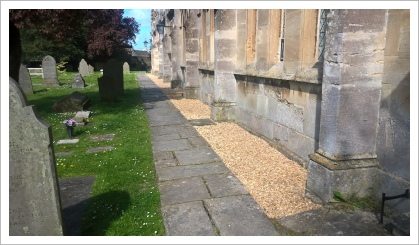
And then the benches were installed….
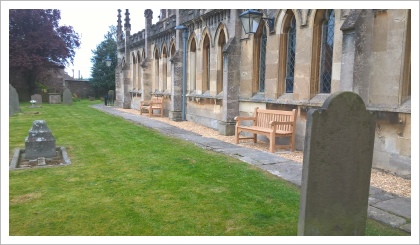
In Spring 2019, with the building of the new frontage at the West Door to allow disabled access to the church, the stone troughs that had been located either side of the entrance, were relocated to fill two of the empty alcoves. Seeing how much they softened the stark looking gravel, (Chesil Beach always came to mind!!) we then purchased and installed two more to fill the remaining empty alcoves. Planted with small box balls and seasonal plants (Tete a Tetes and pansies in the winter/spring and trailing geraniums in the summer) they have made a welcome addition and have completed the project.
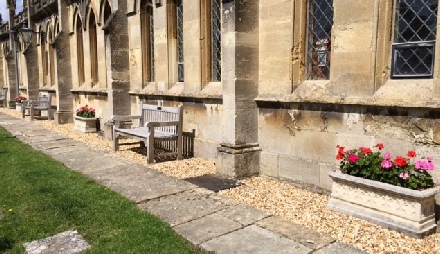
************
Eco-friendliness
When we adopted the churchyard in 2009, we built a purpose made compost area, the slate and rubbish at the rear of the substation was removed and six wildlife nesting boxes including an owl box, were erected in the trees.
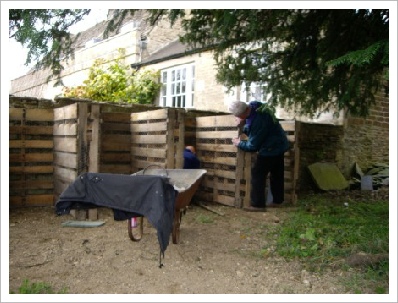
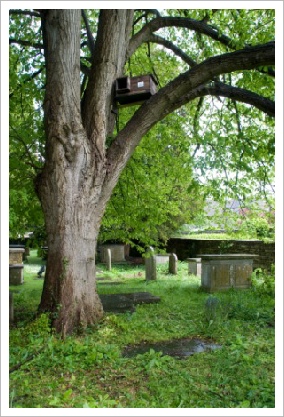
Building the compost area and an owl box erected in one of the trees (although sad to say, never used!)
An old coal bunker situated at the side entrance to the churchyard was also altered. The roof and front were demolished and the remaining three sides were finished along the top with coping stones. It is now a wonderfully useful ‘Bin Store’ and houses all the dustbins and green bins which use to be left out on the grass area by the gate.
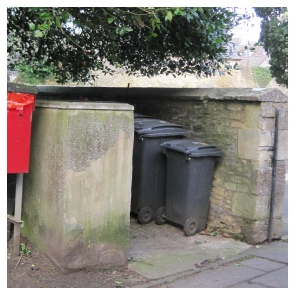
Not a thing of beauty but serves its purpose well!
The old coal bunker which was converted into a bin store (with adjacent pooh bin!)
Our Work Is Ongoing
Our work within the churchyard carries on and each year we try to build on its success. Our aim is to make what is already a beautiful churchyard into somewhere that is truly stunning.
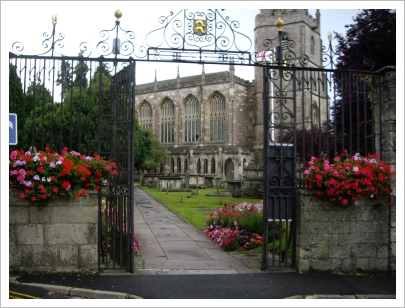
* Note for anyone whose “grammar-sense” was alerted by the placing of the apostrophe in St Marys’ above:
The church is jointly dedicated to Saint Mary the Virgin and Saint Mary Magdalene
- hence there are two Saint Marys (or should that be Saints Mary?).